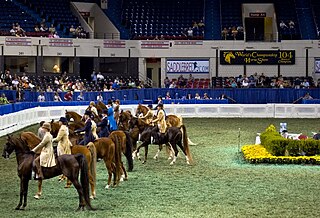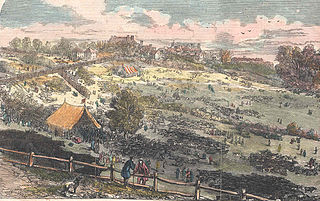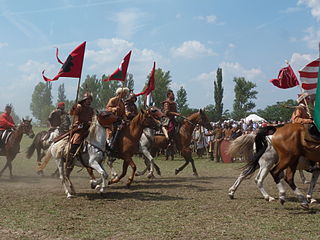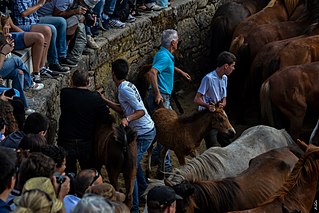 W
WA horse show is an event taking place over days or weeks, comprising competitions and displays in equestrian sports. These are lists of notable horse shows by country or geographical area.
 W
WThe Aoi Matsuri (葵祭), or "Hollyhock Festival," is one of the three main annual festivals held in Kyoto, Japan, the other two being the Festival of the Ages and the Gion Festival. It is a festival of the two Kamo shrines in the north of the city, Shimogamo Shrine and Kamigamo Shrine. The festival may also be referred to as the Kamo Festival. It is held on 15 May of each year.
 W
WThe Appleby Horse Fair, also known as Appleby New Fair, is "an annual gathering of Gypsies and Travellers in the town of Appleby-in-Westmorland in Cumbria, England." The horse fair is held each year in early June, attracting roughly 10,000 Gypsies and Travellers, about 1,000 caravans, several hundred horse-drawn vehicles, and about 30,000 visitors. The Gypsy and Traveller attendees include British Romanichal, Irish Travellers, Scottish Gypsy and Traveller groups, Kale and more.
 W
WThe Ballinasloe Horse Fair is a horse fair which is held annually at Ballinasloe, the second largest town in County Galway, in the western part of Ireland. It is Europe's oldest and largest horse fair, dating back to the 18th century. The annual event attracts up to 80,000 visitors. This festival is one of the most important social and economic events in the life of the town. The town also hosts other horse and pony riding, show jumping and other equestrian activities throughout the year.
 W
WBarnet Fair is an annual horse and pleasure fair held near Mays Lane, Barnet, England, on the first Monday in September.
 W
WThe market town of Beverley in the East Riding of Yorkshire, England, has had a fair since medieval times. In the early days the fairs were places for trading goods and animals, and were useful for meeting people and finding news of what was happening elsewhere in the country. Towns were given the right to hold fairs by Royal charter. In the early 12th century Archbishop Thurstan was granted a charter to hold fairs four times a year, each lasting up to five days. Beverley's medieval fairs were:Feast of St John of Beverley Ascension Day Feast of St John the Baptist Translation of St John of Beverley
 W
WBishop Mule Days is an annual festival celebrating the mule, held in Bishop, California over a six-day period leading up to Memorial Day. More than 700 mules compete in 181 events and the largest non-motorized parade in the United States. It started as a small show in 1969 with a few hundred attendees and has grown to Bishop's largest event, attracting as many as 30,000 spectators. Among mule shows, Bishop Mule Days has been described as "The Granddaddy of Them All".
 W
WThe Great Festival of Fujisaki Hachimangu Shrine is a festival of Fujisaki-hachimangu at Chūō-ku, Kumamoto every September, characterized by a parade of Shinto priests, followed by groups of followers who chase their horses shouting, "Boshita, Boshita", in earlier times; but now the parade followers, "Dookai Dookai", or other phrases. Recently 17,000 people participated in this festival.
 W
WChagu Chagu Umakko (チャグチャグ馬コ) is a horse festival in Iwate Prefecture, Japan. Held on the second Saturday in June, approximately one hundred horses with colourful fittings and bells parade between Sozen Shrine in Takizawa and Morioka Hachiman-gū. The term chagu-chagu is an onomatopoeic expression for the sound made by the horses' bells. In 1978 the festival was recorded as an Intangible Folk Cultural Property. In 1996 the sound of the bells of the Chagu Chagu Umakko was selected by the Ministry of the Environment as one of the 100 Soundscapes of Japan.
 W
WThe Cheltenham Festival is a meeting in the National Hunt racing calendar in the United Kingdom, with race prize money second only to the Grand National. The four-day festival takes place annually in March at Cheltenham Racecourse in Cheltenham, Gloucestershire. It usually coincides with Saint Patrick's Day and is particularly popular with Irish visitors.
 W
WThe Equirria were two ancient Roman festivals of chariot racing, or perhaps horseback racing, held in honor of the god Mars, one February 27 and the other March 14.
 W
WFantasia is a traditional exhibition of horsemanship in the Maghreb performed during cultural festivals and for Maghrebi wedding celebrations. It is present in Algeria, Libya, Mali, Mauritania, Morocco, Niger and Tunisia.
 W
WThe Great Kurultáj or briefly Kurultáj is a traditional event of peoples of Central Asian nomadic origins, which takes place in the first week of August in Bugac, Hungary. The aim of this event is to strengthen the unity of the Eurasian steppe-nomadic horse culture and traditions between Hungarians and their cultural relatives, eastern Turkic peoples and Altaic peoples. The first Kurultáj was held in the Torgai region of Kazakhstan in 2007. The first Kurultáj in Hungary was held in 2008. These events contributed much to the revival of the Altaic self-awareness.
 W
WGymkhana, is a British Raj term which originally referred to a place of assembly. The meaning then altered to denote a place where skill-based contests were held. "Gymkhana" is an Anglo-Indian expression, which is derived from the Persian word "Jamat-khana". Most gymkhanas have a Gymkhana Club associated with them, a term coined during British Raj for gentlemen's club.
 W
WNaadam is a traditional festival in Mongolia. The festival is also locally termed "eriin gurvan naadam", "the three games of men". The games are Mongolian wrestling, horse racing, and archery, and are held throughout the country during midsummer. Women have started participating in the archery and girls in the horse-racing games, but not in Mongolian wrestling.
 W
WIn ancient Roman religion, the October Horse was an animal sacrifice to Mars carried out on October 15, coinciding with the end of the agricultural and military campaigning season. The rite took place during one of three horse-racing festivals held in honor of Mars, the others being the two Equirria on February 27 and March 14.
 W
WPa'u riders, , are wahine horseback riders who wear long, colorful skirts and characteristically ride astride, rather than sidesaddle. This equestrian tradition's roots are from the early 19th century, when horses were introduced to Hawaii and aliʻi women dressed up to ride for formal occasions. It declined after the overthrow of the Kingdom of Hawaii, but was revitalized in the early 20th century with the establishment of formal riding organizations called Pa'u Riders. Today, they participate in Kamehameha Day floral parades and other parades and festivals throughout the islands.
 W
WA rapa das bestas is the name given to the annual curro (roundup) of wild horses celebrated the first Friday, Saturday, Sunday and Monday of July in Sabucedo, A Estrada (Pontevedra), Spain.
 W
WThe Taurian Games were games (ludi) held in ancient Rome in honor of the di inferi, the gods of the underworld. They were not part of a regularly scheduled religious festival on the calendar, but were held as expiatory rites religionis causa, occasioned by religious concerns.
 W
WThe Winter Equestrian Festival (WEF) is an annual equestrian festival running for 12 weeks between January and April in Wellington, Florida. Each of the 12 weeks is considered its own horse show, with separate competitions, as well as competitions that run throughout the festival. It is the largest and longest-running equestrian competition in the world. The Winter Equestrian Festival is known for its stunning grounds and villages, stiff competition, and wealth of its participants.